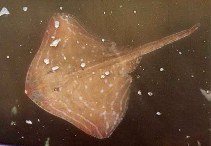Raja microocellata Montagu, 1818
Small-eyed ray
Add your observation in Fish Watcher
| Native range | All suitable habitat | Point map | Year 2050 |

|
| This map was computer-generated and has not yet been reviewed. |
| Raja microocellata AquaMaps Data sources: GBIF OBIS |
Upload your photos and videos
Pictures | Google imageRaja microocellata
Picture by Meyer, T.
Pictures | Google imageRaja microocellata
Picture by Meyer, T.
Spain country information
Common names:
Painted ray, Raia colorada, Raya
Occurrence: native
Salinity: marine
Abundance: | Ref:
Importance: | Ref:
Aquaculture: | Ref:
Regulations: | Ref:
Uses: no uses
Comments: Found in Galicia (Ref. 86578).
National Checklist:
Country Information: https://www.cia.gov/library/publications/resources/the-world-factbook/geos/sp.html
National Fisheries Authority:
Occurrences: Occurrences Point map
Main Ref: Stehmann, M. and D.L. Bürkel, 1984
National Database: ICTIMED
Occurrence: native
Salinity: marine
Abundance: | Ref:
Importance: | Ref:
Aquaculture: | Ref:
Regulations: | Ref:
Uses: no uses
Comments: Found in Galicia (Ref. 86578).
National Checklist:
Country Information: https://www.cia.gov/library/publications/resources/the-world-factbook/geos/sp.html
National Fisheries Authority:
Occurrences: Occurrences Point map
Main Ref: Stehmann, M. and D.L. Bürkel, 1984
National Database: ICTIMED
Common names from other countries
Classification / Names Common names | Synonyms | Catalog of Fishes(genus, species) | ITIS | CoL | WoRMS | Cloffa
Elasmobranchii (sharks and rays) > Rajiformes (Skates and rays) > Rajidae (Skates)
Etymology: Raja: Latin, raja, -ae = a sting ray (Raja sp.) (Ref. 45335).
Etymology: Raja: Latin, raja, -ae = a sting ray (Raja sp.) (Ref. 45335).
Environment: milieu / climate zone / depth range / distribution range Ecology
Marine; demersal; depth range ? - 100 m (Ref. 4426). Temperate; 55°N - 24°N, 16°W - 1°W
Distribution Countries | FAO areas | Ecosystems | Occurrences | Point map | Introductions | Faunafri
Eastern Atlantic: southwestern England and Ireland to Rio de Oro in Western Sahara; absent from the North Sea and the Mediterranean.
Length at first maturity / Size / Weight / Age
Maturity: Lm 74.0, range 73 - ? cm
Max length : 87.0 cm TL male/unsexed; (Ref. 6014); max. published weight: 4.5 kg (Ref. 4699)
Max length : 87.0 cm TL male/unsexed; (Ref. 6014); max. published weight: 4.5 kg (Ref. 4699)
Short description Identification keys | Morphology | Morphometrics
Dorsal spines (total): 0; Anal spines: 0. Eyes conspicuously small; dorsal fins close-set, no thorns between; upper surface predominantly spinulose, underside almost smooth in young, but head and centre of disc prickly in larger specimens; orbital thorns separate, a regular row of about 50 thorns from nape to first dorsal fin; upper surface greyish, olive to light brown with light blotches and long bands, underside white (Ref. 3167).
Found on sandy bottoms, from inshore waters to about 100 m in tidal areas (Ref. 3167). Feed on fishes (Ref. 3167). Oviparous. Distinct pairing with embrace. Young may tend to follow large objects, such as their mother (Ref. 205). Eggs are oblong capsules with stiff pointed horns at the corners deposited in sandy or muddy flats (Ref. 205). Egg capsules are 6.6-10.0 cm long and 4.1-6.3 cm wide (Ref. 41250). About 54-61 eggs are laid by an individual in a year (Ref. 41250).
Life cycle and mating behavior Maturity | Reproduction | Spawning | Eggs | Fecundity | Larvae
Oviparous (Ref. 3167). Paired eggs are laid. Embryos feed solely on yolk (Ref. 50449). Distinct pairing with embrace. Young may tend to follow large objects, such as their mother (Ref. 205).
Main reference
Upload your references | References | Coordinator : McEachran, John | Collaborators
McEachran, J.D. and K.A. Dunn, 1998. Phylogenetic analysis of skates, a morphologically conservative clade of elasmobranchs (Chondrichthyes: Rajidae). Copeia 1998(2):271-290. (Ref. 27314)
IUCN Red List Status (Ref. 130435: Version 2024-1)
Near Threatened (NT) ; Date assessed: 13 February 2006
Threat to humans
Harmless
Human uses
Fisheries: minor commercial; gamefish: yes
FAO(Fisheries: production; publication : search) | FishSource | Sea Around Us
More information
Population dynamics
Growth parameters
Max. ages / sizes
Length-weight rel.
Length-length rel.
Length-frequencies
Mass conversion
Recruitment
Abundance
Growth parameters
Max. ages / sizes
Length-weight rel.
Length-length rel.
Length-frequencies
Mass conversion
Recruitment
Abundance
Life cycle
Reproduction
Maturity
Fecundity
Spawning
Spawning aggregations
Eggs
Egg development
Larvae
Larval dynamics
Reproduction
Maturity
Fecundity
Spawning
Spawning aggregations
Eggs
Egg development
Larvae
Larval dynamics
Physiology
Body composition
Nutrients
Oxygen consumption
Swimming type
Swimming speed
Visual pigments
Fish sound
Diseases & Parasites
Toxicity (LC50s)
Body composition
Nutrients
Oxygen consumption
Swimming type
Swimming speed
Visual pigments
Fish sound
Diseases & Parasites
Toxicity (LC50s)
Genetics
Genetics
Heterozygosity
Heritability
Genetics
Heterozygosity
Heritability
Human related
Aquaculture systems
Aquaculture profiles
Strains
Ciguatera cases
Stamps, coins, misc.
Aquaculture systems
Aquaculture profiles
Strains
Ciguatera cases
Stamps, coins, misc.
Tools
E-book | Field guide | Length-frequency wizard | Life-history tool | Point map | Classification Tree
| Catch-MSY |
Special reports
Download XML
Internet sources
Aquatic Commons | BHL | Cloffa | Websites from users | Check FishWatcher | CISTI | Catalog of Fishes(genus, species) | DiscoverLife | ECOTOX | Faunafri | Fishtrace | GenBank(genome, nucleotide) | GloBI | GOBASE | | Google Books | Google Scholar | Google | IGFA World Record | MitoFish | National databases | Otolith Atlas of Taiwan Fishes | PubMed | Reef Life Survey | Scirus | SeaLifeBase | Tree of Life | Wikipedia(Go, Search) | World Records Freshwater Fishing | Zoological Record
Estimates based on models
Preferred temperature (Ref. 115969): 10.4 - 15.4, mean 12 (based on 138 cells).
Phylogenetic diversity index (Ref. 82804): PD50 = 0.5000 [Uniqueness, from 0.5 = low to 2.0 = high].
Bayesian length-weight: a=0.00468 (0.00295 - 0.00741), b=3.30 (3.17 - 3.43), in cm Total Length, based on LWR estimates for this species & Genus-body shape (Ref. 93245).
Trophic level (Ref. 69278): 3.9 ±0.2 se; based on diet studies.
Resilience (Ref. 120179): Low, minimum population doubling time 4.5 - 14 years (Fec= 54-61).
Fishing Vulnerability (Ref. 59153): Moderate to high vulnerability (55 of 100).
Climate Vulnerability (Ref. 125649): Very high vulnerability (88 of 100).




